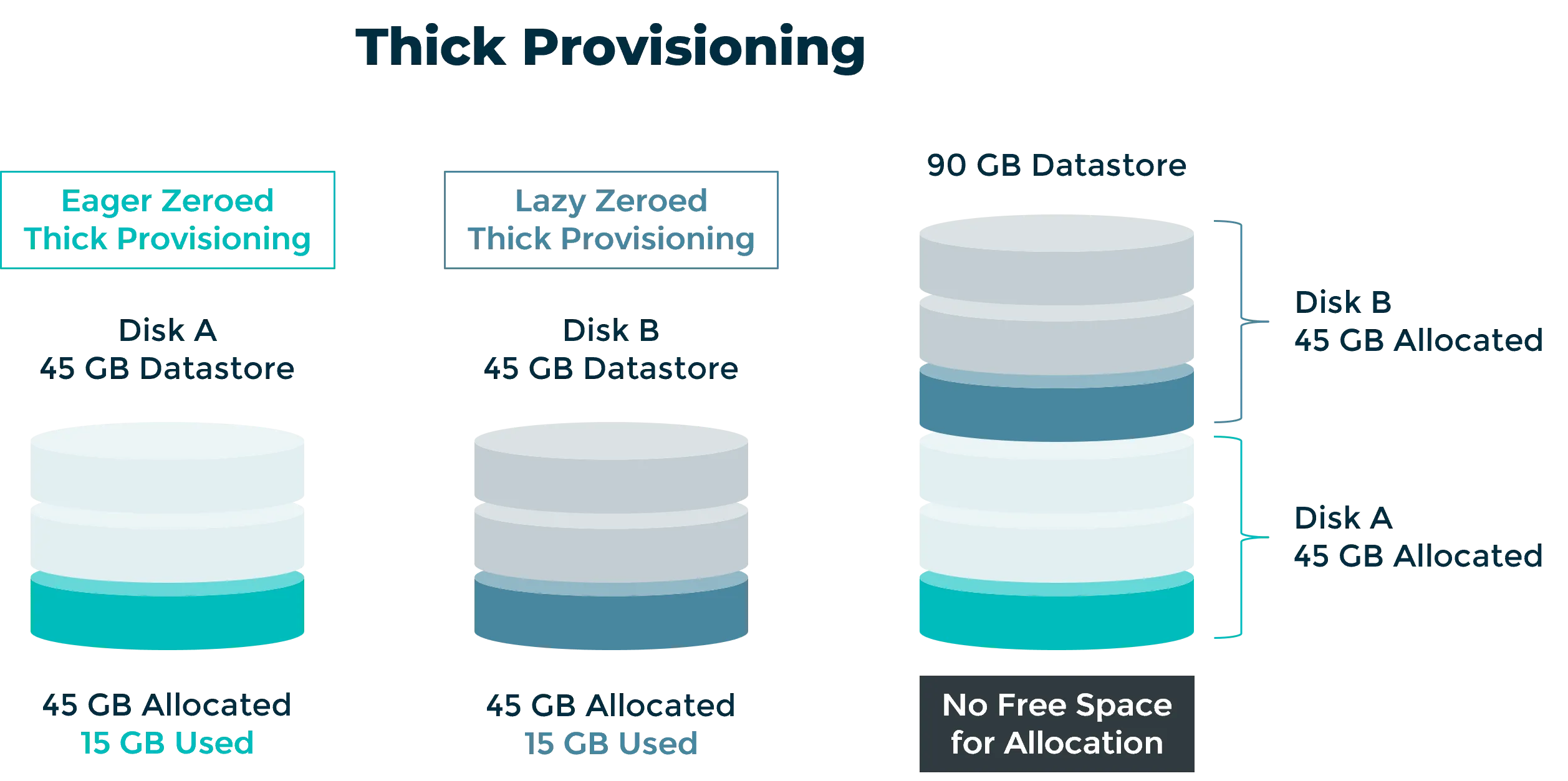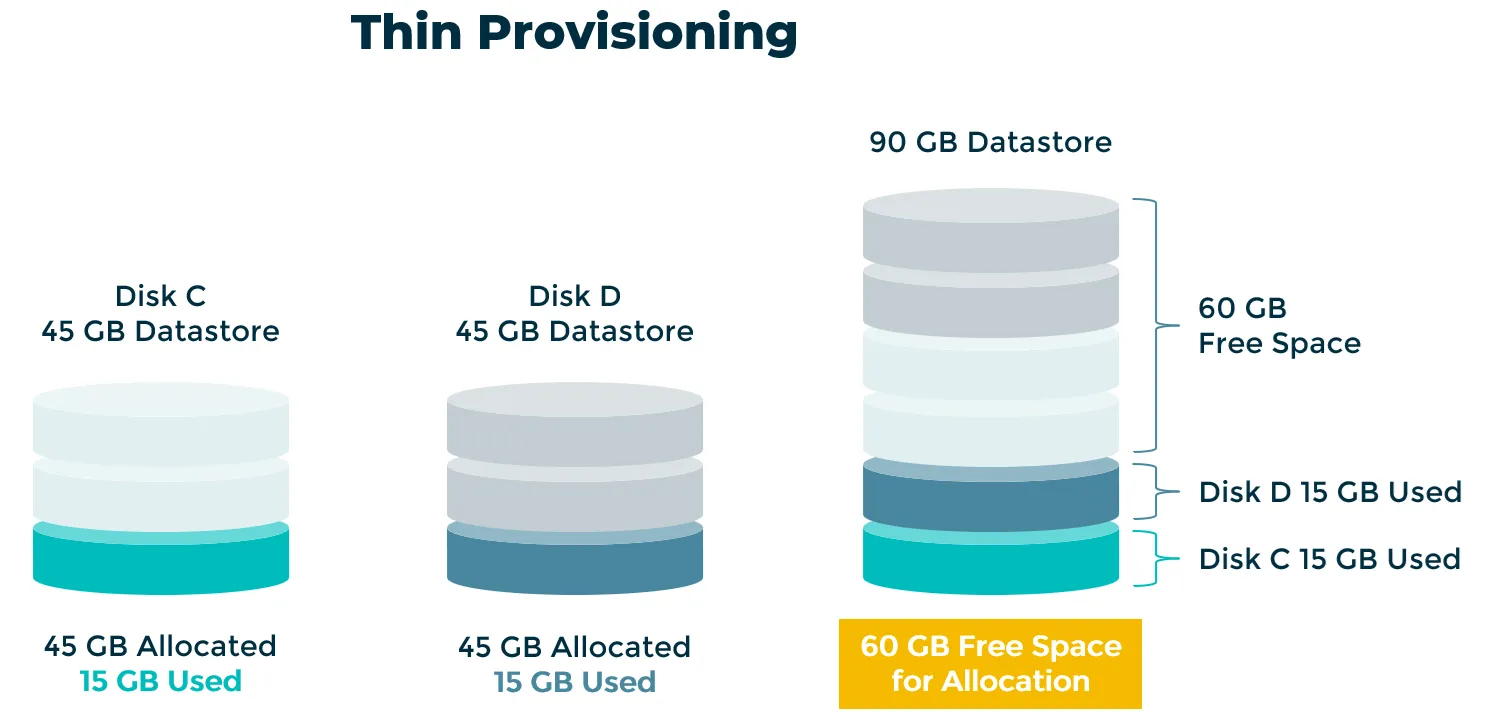In the realm of data storage management, the debate of thin vs. thick provisioning is pivotal for IT professionals seeking to optimize their storage infrastructure. Both provisioning methods offer distinct advantages and challenges, influencing performance, cost, and efficiency. This guide delves into the technical nuances of thin and thick provisioning, providing a comprehensive comparison to help you make an informed decision based on your specific storage needs.
Thick Provisioning
Definition of Thick Provisioning
Thick Provisioning is a storage capacity management approach where a fixed amount of disk space is pre-allocated to a virtual volume or dataset from the get-go. This capacity is dedicated and reserved for that particular volume, independent of the actual amount of data stored. It comes in two variants:
- Eager Zeroed Thick Provisioning: This technique not only allocates disk space upfront but also zeroes out all the allocated space immediately. This zeroing process ensures that any residual data is erased, providing a clean slate for new data. This is particularly important in environments that prioritize data integrity and security, as it eliminates the possibility of old data remnants being accessible. The eager zeroing also benefits performance for write-intensive applications since the storage is already prepared to receive new data without the overhead of cleaning operations during write processes.
- Lazy Zeroed Thick Provisioning: Contrasting with its eager counterpart, lazy zeroed provisioning allocates disk space without immediately zeroing it. The space is marked for use and will be zeroed on-demand as data writes occur. This method speeds up the initial provisioning process because it skips the upfront zeroing operation. However, it may introduce a performance penalty the first time each sector is written to, as the disk needs to zero the space before writing new data, potentially impacting write performance in scenarios where immediate high-speed writing is required.

| Advantages of Thick Provisioning | Disadvantages of Thick Provisioning |
|---|---|
| Performance Benefits: By allocating disk space upfront, thick provisioned vs thin provisioned environments often benefit from improved disk performance, as the storage system does not need to allocate space on the fly. | Inefficient Storage Utilization: Given that all space is allocated upfront, thick provisioning can lead to unused disk space, making it less efficient compared to thin provisioning. |
| Predictability and Simplicity: The disk space is fully allocated from the start, making capacity planning more straightforward and predictable. | Cost Implications: Occupying disk space that isn’t immediately needed can lead to higher storage costs, particularly in environments where disk capacity is at a premium. |
Thin Provisioning
Definition of Thin Provisioning
Thin Provisioning is a dynamic storage allocation method that contrasts sharply with thick provisioning by allocating disk space only as it is actually needed for data storage, rather than reserving it upfront. This approach involves the creation of a virtual storage pool that appears to the operating system and applications as if a large volume of disk space is available, regardless of the physical storage capacity immediately available.
As data storage requirements increase, thin provisioning dynamically allocates additional disk space from the storage pool to the virtual volume, up to the maximum defined limit. This method is highly efficient, as it minimizes wasted disk space and allows for overcommitment, where the total size of all virtual volumes can exceed the actual physical storage capacity, relying on the unlikely scenario that all volumes will use their maximum allocated space simultaneously.

| Advantages of Thin Provisioning | Disadvantages of Thin Provisioning |
|---|---|
| Efficient Storage Utilization: Thin provisioning shines in its ability to reduce wasted disk space, allocating storage precisely when it’s required | Performance Overhead: The dynamic allocation of disk space can introduce latency and may impact disk performance. It needs proper planning. |
| Cost Savings: By not allocating disk space that isn’t immediately needed, thin provisioned setups can significantly lower initial storage costs. | Management Complexity: Thin provisioning may require storage management tools to manage disk space efficiently and prevent overprovisioning |
| Scalability and Flexibility: It offers unparalleled flexibility in storage management, allowing for easy scaling as data requirements increase. | Risk of Overprovisioning: The potential to allocate more virtual storage than the physical disk can support is a notable risk, which could lead to data loss or service interruptions if not managed properly. |
Choosing Between Thin and Thick Provisioning
Deciding between thin vs thick provisioning is a strategic choice that hinges on several critical factors. Each method has its unique advantages and is suited to different scenarios based on organizational needs, performance requirements, and future growth projections.
Factors to Consider
- Budget Constraints: Thick provisioning often demands a higher initial investment because it requires purchasing enough storage to meet the maximum anticipated demand upfront. This approach can lead to higher capital expenditures early on but may offer simplified management and predictable performance. On the other hand, thin provisioning minimizes initial costs by allowing storage to be added dynamically as needed, which can ease budget constraints but requires more sophisticated monitoring to manage effectively.
- Performance Requirements: For applications with high I/O demands, such as databases or high-transaction systems, thick provisioning is generally preferred. The pre-allocation of disk space ensures that storage performance is not hindered by dynamic allocation delays, providing consistent and reliable access times. Conversely, thin provisioning may introduce a slight performance overhead due to the on-the-fly allocation of disk space, which could impact applications sensitive to latency.
- Management Complexity: Thin provisioning introduces a layer of complexity in storage management, necessitating advanced tools and diligent monitoring to ensure that storage capacity is not exceeded and that performance levels are maintained. It requires a proactive approach to storage management, with strategies in place for dealing with storage demand spikes and avoiding overprovisioning. Thick provisioning, by contrast, is more straightforward since the disk space is fully allocated from the outset, reducing the need for continuous monitoring but potentially leading to inefficiencies in space utilization.
- Future Growth Projections: The scalability and flexibility of thin provisioning make it an attractive option for organizations with unpredictable growth patterns or those looking to scale their operations dynamically. It allows for easy addition of storage resources as demand increases without the need to overcommit resources upfront. Thick provisioning, however, may be more suitable for environments with stable, predictable growth where the future storage needs can be accurately forecasted, ensuring that the necessary disk space is available when needed without the risk of overallocation.
Ideal Scenarios for Thin and Thick Provisioning
- When to Choose Thin Provisioning: Ideal for dynamic environments with fluctuating or unpredictable storage needs. It’s also well-suited for startups and SMBs where initial capital is limited, and the cost-effectiveness of storage management is paramount. Cloud environments often leverage thin provisioning to maximize disk utilization and provide scalable storage solutions to multiple tenants.
- When to Choose Thick Provisioning: Best for enterprise environments where performance and predictability are critical. Applications that require high levels of data throughput, such as large databases, video editing suites, or any application where latency could significantly impact operations, benefit from the immediate availability of disk space and the consistent performance that thick provisioning offers. It’s also suitable for environments where the administrative overhead of constantly monitoring and managing storage allocation can be justified by the need for performance and reliability.
In essence, the choice between thin provisioning vs thick provisioning should be guided by a thorough analysis of current and projected storage requirements, budgetary constraints, performance needs, and management capabilities. Balancing these factors will lead to a decision that best supports the organization’s operational objectives and growth strategies.
How DataCore Can Help
In the complex terrain of data storage management, DataCore SANsymphony emerges as a powerful ally, seamlessly bridging the gap between the efficiency of thin provisioning and the reliability of thick provisioning. This sophisticated storage virtualization platform enhances the flexibility and performance of storage infrastructures, offering a comprehensive suite of features designed to optimize and streamline data management processes. By intelligently automating storage allocation across diverse storage hardware, SANsymphony ensures that organizations can achieve the perfect balance of performance, cost-efficiency, and scalability, regardless of their provisioning strategy.
SANsymphony’s advanced capabilities extend beyond simple provisioning to offer AI-enabled data tiering, high availability and disaster recovery solutions. Its intuitive management interface simplifies the complexities associated with thin and thick provisioning, allowing for flexible adjustment of storage resources to meet evolving demands. Whether you’re looking to maximize storage utilization with thin provisioning or ensure peak performance with thick provisioning, SANsymphony provides the tools and insights needed to elevate your storage strategy to new heights of efficiency and reliability.